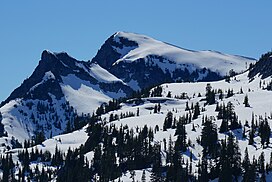Iron Cap Mountain
| Iron Cap Mountain | |
|---|---|
 East aspect | |
| Highest point | |
| Elevation | 6,347 ft (1,935 m)[1][2] |
| Prominence | 787 ft (240 m)[1] |
| Parent peak | Big Snow Mountain (6,680 ft)[3] |
| Isolation | 1.74 mi (2.80 km)[3] |
| Coordinates | 47°33′14″N 121°17′08″W / 47.553833°N 121.285424°W[1] |
| Geography | |
| Country | United States |
| State | class 2-3 scrambling North Ridge[4] |
Iron Cap Mountain is a 6,347-foot (1,935-metre) mountain summit located two miles west-northwest of Dutch Miller Gap, in east
Climate

Iron Cap Mountain is located in the
Geology
The Alpine Lakes Wilderness features some of the most rugged topography in the
The history of the formation of the Cascade Mountains dates back millions of years ago to the late
During the Pleistocene period dating back over two million years ago, glaciation advancing and retreating repeatedly scoured the landscape leaving deposits of rock debris.[7] The last glacial retreat in the Alpine Lakes area began about 14,000 years ago and was north of the Canada–US border by 10,000 years ago.[7] The U-shaped cross section of the river valleys is a result of that recent glaciation. Uplift and faulting in combination with glaciation have been the dominant processes which have created the tall peaks and deep valleys of the Alpine Lakes Wilderness area.
See also
- List of peaks of the Alpine Lakes Wilderness
- Geology of the Pacific Northwest
- Ann Nelson
- Iron Cap Lake
References
- ^ a b c d "Iron Cap Mountain, Washington". Peakbagger.com.
- ^ a b c d e f Beckey, Fred W. Cascade Alpine Guide, Climbing and High Routes. Seattle, WA: Mountaineers Books, 2008.
- ^ a b "Iron Cap Mountain - 6,347' WA". listsofjohn.com. Retrieved 2020-08-10.
- ^ "Iron Cap Mountain". Bivouac.com. Retrieved 2020-08-10.
- ^ "Iron Cap Mountain". Geographic Names Information System. United States Geological Survey, United States Department of the Interior. Retrieved 2020-08-10.
- ^ Smoot, Jeff (2004). Backpacking Washington’s Alpine Lakes Wilderness. Helena, Montana: The Globe Pequot Press.
- ^ a b c d e Kruckeberg, Arthur (1991). The Natural History of Puget Sound Country. University of Washington Press.
External links
- Weather forecast: Iron Cap Mountain
- Alpine Lakes Wilderness (Mt. Baker-Snoqualmie National Forest) U.S. Forest Service
- Injured hiker rescued: CNN


